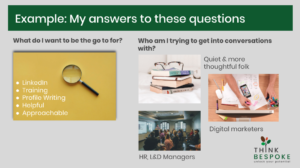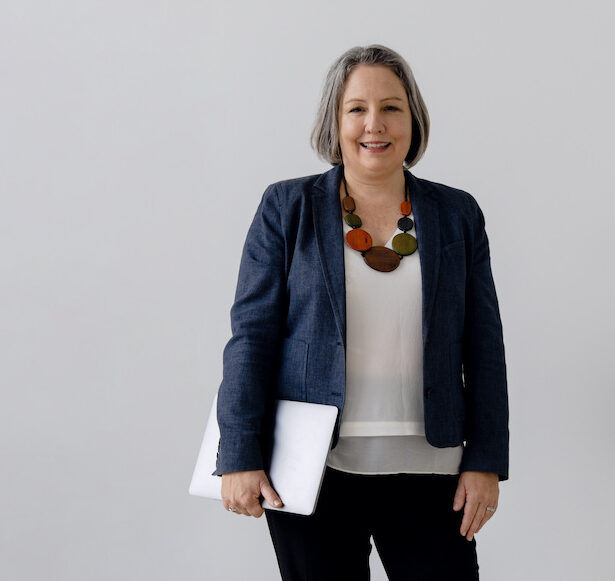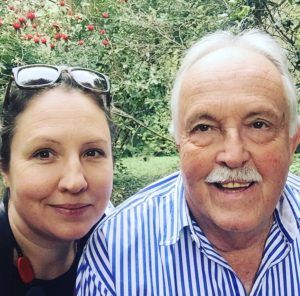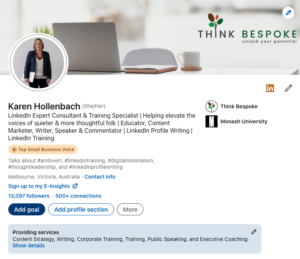5 Steps to Build Your Personal Brand
In this article you will learn 5 steps to build your personal brand online so you can make it easier for people to understand what you’re good at and who they can send your way (e.g. client referrals) and suitable roles or board positions they can recommend you for.
As a LinkedIn Expert Consultant I have conversations with business and professional communities around Australia about how LinkedIn can help build your personal brand. What I am noticing is the pressure to ‘put yourself out there’, especially online, and definitely on LinkedIn if operating in the B2B or professional services industries.
Personal branding, and helping people understand why this is so important, is central to modern professional success and maximising your time on LinkedIn. Some people call it online reputation management, and some people reject the idea completely. Whatever your view of this concept, today’s article shares my experience as an ambivert with personal branding. If you are new to the concept of an ambivert, it’s someone who is in the middle of the introvert and extrovert continuum. I share this with you because personal branding sometimes feels like something extroverts do well, and the rest of us are inclined to shy away from what we perceive to be self promotion.
While personal branding is not something I am entirely comfortable with, I have learnt to embrace it as a tool that’s aligned with my values. When I do ‘show up online’ I focus on who I’m helping, rather than comparing myself to others. This approach has helped me get out of my own way. Having consistently cultivated my personal brand in various ways for over 13 years, since establishing Think Bespoke, it’s been the key factor that’s helped raise my profile and helped me achieve my professional and business goals.
5 Steps to Build Your Personal Brand
Cultivating a personal brand is about deciding the parts of yourself you’d like to shine a light on via your LinkedIn profile and when you talk about yourself at networking events. It’s also the topics you are likely to talk about when you are on LinkedIn, either as a content creator or a curator, re-poster or someone who comments on other people’s updates.
Deciding this focus makes it easier for people to understand what you’re good at, how you approach your work, who they can send your way (e.g. client referrals) and suitable roles or board positions they can recommend you for. To help you better understand this, and how personal branding can play a role in helping you achieve your professional goals, here are my 5 steps to build a personal brand online.
1. Know What You Want to be Known For or the ‘Go to’ For
Knowing what you want to be known for, or the ‘go to’ for, means taking some time to think about what you’re really good at, what you’re passionate about and how you conduct yourself as a professional.
For business owners: It should be the type of work you want people to be recommending you for. e.g. she does WordPress websites, he’s an SEO copywriter, she’s an expert in Squarespace.
For business leaders: Your professional approach, a key area of transformation or your networks may be more relevant. e.g. she builds high performing teams, he’s focused on cultural transformation, she’s great at corporate governance and risk management, she has strong connections across all levels of government.
At a basic level, my answers to this question looks like this:
- Subject Matter Expertise: LinkedIn
- Professional Approach: Helpful and approachable
Knowing your answer to this question helps you be more strategic, focused and intentional when you spend time on platforms like LinkedIn to help raise your profile and educate others about what you do and how you can help. It’s a critical part of demonstrating your value as a unique individual who wants to make the world a better place to live in.
That’s why I recommend you write this question down and give it some deep consideration. If you journal, spend time writing about this concept and what it means to you. If you like to take long walks, spend some time ruminating over this concept on your next walk.
Here’s my dear dad, Paul. Some of the best advice he gave me when I finished my business degree at RMIT and was navigating my first few jobs was ‘Your most treasured possession is your name’.
This is so true and relates well to other commentator’s views that your personal brand is what people say about you when you are not in the room.
So what is it that you want people to say about you?
This is the first step in developing your personal brand.
2. Know Who You Are Trying to Influence and Get into Conversations With
Being clear about who you want to influence and get into conversations with helps you consider how you write and talk about yourself and the types of conversations you lead, contribute to and comment on. I found focusing on this element extremely helpful, as it made the concept of personal branding less about me and more about how I could help others. I’ve heard some people talk about this in terms such as ‘who do you serve’. How you answer this question and whether you are trying to influence people (or not), get into conversations with people (or not) and serve certain communities (or not), is a helpful way to get clarity on the topics you do / do not care about.
I love gardening, but I don’t talk about this much on LinkedIn, beyond encouraging people to ‘tend to their LinkedIn garden (LinkedIn profile)’ and the idea that I ‘plant seeds in people’s minds’.
What I do talk about is quieter and more thoughtful folk, ambiverts and those who feel more tentative about LinkedIn. My clients tend to be conservative in nature and may not identify as a ‘a social media person’. They want to know how to navigate LinkedIn more effectively, without compromising their values or come across as someone who is bragging about their efforts. Some of my potential clients are also put off by the more extroverted behaviours they see on LinkedIn, and this has stopped them from being more active there.
To answer this question effectively I recommend you actively listen to your clients and stakeholders, review the types of people and organisations you like working with and consider who are your favourites, or the ones you need to be spending more time with to learn and create opportunities for your career or business. When you tune in, and start to better understand the current challenges they are facing, this will also help inform the content topics you may wish to explore on LinkedIn that can help them deal with these challenges.

It’s the reason I enjoy LinkedIn. This intentional and more strategic focus is a time saver by driving most of my behaviour when engaging with others on LinkedIn, either via messaging or when I comment on connection’s updates. Remember, your time is precious, so use it wisely.
I want to get into conversations with quiet and more thoughtful folk who need help with writing their LinkedIn profiles or LinkedIn training; Learning and Development Managers or Heads of Departments who want to get LinkedIn training for their teams and Digital Marketing Managers who want LinkedIn marketing mentoring, training or need their stakeholders or clients profiles updated.
Now it’s time to consider your version of this.
3. Be You and Know How to Position This as Your Super Power
The mistake I see many business owners play (and I have made it myself in the past) is to compare themselves to others and be a version of the leader in their industry. This is distracting and unproductive, because your super power is being you! It is dangerous and limiting to compare yourself to others and much more productive to consider who you are trying to influence and in what way you can help them.
In these articles below I feel myself drawing closer to who I am. This might sound strange and is a difficult concept to explain, but one that I know resonates with my ideal clients who are thoughtful and quieter folk wishing to make a difference in their roles and business.
I believe there is plenty of work for everyone and so if you powerfully stand in the space that is uniquely you, your clients will eventually hear about you. it’s time to be you, because everyone else is taken!
Cultivating Your Personal Brand on LinkedIn
Below is my LinkedIn profile intro card, which I’m sharing with you as an example of how to focus in on the key components of your personal brand. The imagery is just as important as the words and features you activate within your profile.
Imagery: They say a picture is worth a thousand words. For my LinkedIn profile I’ve chosen a background image that’s consistent with Think Bespoke’s website and includes the company logo. It’s important to show not tell.
- Think about what this photo evokes for you.
- Now consider the imagery on your profile and website (if relevant) and what story this is telling.
- How is it supporting the cultivation of your personal brand online?
Profile Photo: I invested in professional photography with Fi Mims, a number of years ago. You can read on to learn more about this experience. Since getting these photos done I have chosen to return to my natural hair colour, and so I have updated my professional photos. While I do not love having my photo taken, I understand the importance of being able to connect with a human face. My profile photo is what I look like when I train clients. I’m not overly enthusiastic in this picture, but I am smiling (sort of) and hopefully I do look approachable. I am often deep in thought or deeply listening, so I’m hoping this comes through in some way with this photo.
- Take a fresh look at your LinkedIn profile photo.
- Is it telling the story that makes sense for your personal branding goals?
Headline: As a lover of the written word, I believe words are also a powerful force to help tell your story. My headline references both what I want to be known for and who I am trying to influence, and get into conversations with. You have 220 characters available in your LinkedIn profile headline to communicate this message.
- Is your profile headline in the default mode, simply listing your role title and the company you’re currently working for?
- Take some time to re-word this section of your profile because it follows you around LinkedIn when you like and comment on LinkedIn posts and updates.
Creator Mode: The 5 hashtags listed on my profile are activated via Creator Mode. They tell people visiting my profile the topics I care about and commentate on. If you’re yet to activate Creator Mode and want to better understand the value of this free LinkedIn feature, please read the article below.
4. Invest in Professional Photography
More people are realising the importance of looking their professional best online. It took me quite some time to come around to the importance of your physical presentation in influencing your message, but it has been a journey I’ve enjoyed. It is critical to invest in a professional headshot photo that reflects what you look like when people meet you. At the very least it needs to be on your LinkedIn Profile photo and About Us website page featuring you.
If you live in Victoria, here’s some options for personal branding and LinkedIn headshot photographers.
5. Consider the Role of a Branding Photo Shoot
This one took me a long time to get my head around and is not for everyone, especially if you are like me and have ambivert or introvert tendencies. As a lover of the written word, it just does not feel that comfortable to commit time, money or headspace into a branding photo shoot. What I have discovered is that it is an essential part of finding your voice, telling your story and building your online profile and professional brand.
After a chance encounter over dinner with a professional photographer in my network I decided to invest my energies in developing a series of photography that would better showcase, me, my services and approach. It was uncomfortable, but I’m really happy with the results. Here’s a video done by Fi of Fi Mims Photography (who led me through this experience) after my first round of professional photos.
This was taken on the day we did this branding shoot. Note how uncomfortable I seem at the start of the day and my relief and happiness at the end! I’m glad I did this and encourage you to do the same.
I also suggest you need to consider the role of writing a blog or LinkedIn newsletter, podcasts or guest speaking, being an advocate for your clients and building communities.
Need help with LinkedIn?
Browse Think Bespoke’s website library and knowledge base for helpful articles about LinkedIn Training, LinkedIn Profile, LinkedIn Marketing and Career Management.



